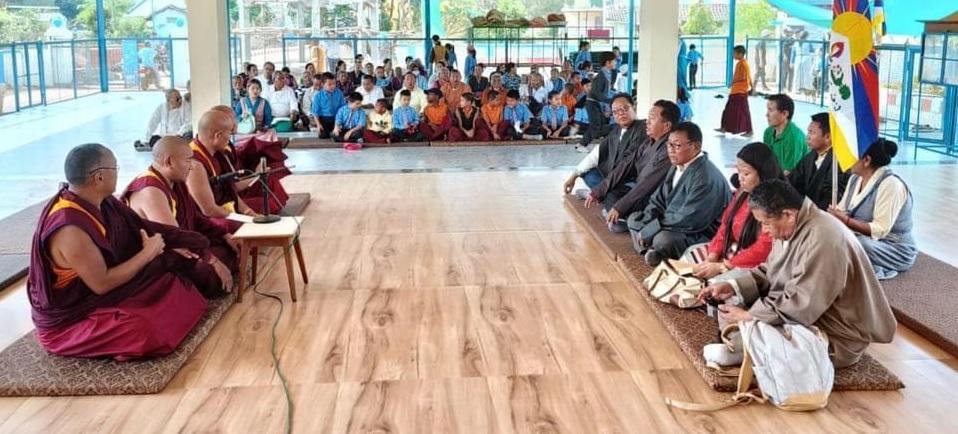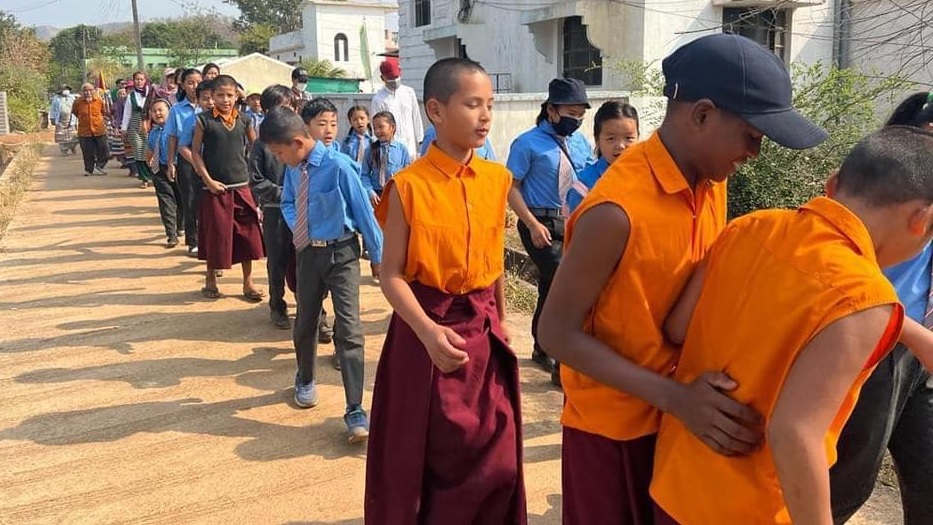Maharashtra: Tibetan Community In Gondia District Honors Those Who Fought Against Chinese Rule

Gondia, 10th March 2023: The Tibetan community living in the Norgyeling Tibetan settlement in the Gondia district today observed the Tibetan national uprising day to show their dedication to the cause of their forefathers. In 1959, the Tibetans had risen against the Chinese government to fight for their religious freedom, and their struggle remains relevant today. The members of the regional Tibetan Youth Congress distributed ten thousand pamphlets on the issue of the Tibetan uprising day in Arjuni Morgaon, Sakori, and Bhandara.
To commemorate the Tibetan National Uprising Day, the Tibetan refugees at Norgyeling Tibetan settlement gathered at the settlement office and read the statement of the Central Tibetan Administration in exile. They marched to the local monastery and offered special prayers to honour the memory of those who sacrificed their lives for the Tibetan cause. The Regional Tibetan Youth Congress and settlement office members organized the event, which saw the participation of the resident Tibetan community, including young school children, demonstrating their strong resolve and commitment to their forefathers’ cause.
Although the Tibetan community that was forced to migrate from their homeland in 1959 and subsequent years has dwindled, the memories of religious persecution and subversion remain alive. Despite the lack of progress on the ground, the Tibetan community remains steadfast in their commitment to the cause of religious freedom. They believe that the Chinese authorities are increasingly trying to tighten their grip on Tibet. The Chinese government’s targeting of Tibet started well before 1959 in the form of so-called democratic reforms imposed in the Kham and Amdo regions of Tibet.

Tibetans were subjected to land reforms and a cooperative system, which was used as a pretext to confiscate their land, livestock, and means of production in the name of collectivization. Monks and nuns were forced to disrobe, and monasteries were demolished under the guise of religious reform. The 1959 Tibetan uprising was a desperate attempt by the Tibetans to preserve their centuries-old religious identity, as they began feeling threatened about their existence. Those who stood up against the administration were labeled as bandits and rebels.
HH the Dalai Lama and ministers of the Kashag (Tibetan cabinet) started their march into exile on March 10, 1959, followed by around 80,000 Tibetans, including Tibetan government officials. However, there was no respite in the subsequent years, as the development policies of Deng Xiaoping in the 1980s led to further colonization of Tibet by exploiting the natural resources of the region through the creation of large dams and infrastructure projects. This resulted in the widespread resettlement and destruction of Tibetan people and resources. While the projects led to the development of western or coastal China, they came at the expense of the Tibetan people and led to an increase in income inequality between China and Tibet.
Presently, the PRC government is pursuing a policy of “one nation, one culture, one religion, one language,” whereby Tibetan children are forced to learn Mandarin starting from kindergarten schools. Marriages between Tibetan and Chinese are being rewarded to promote the so-called model family of ethnic harmony. The relocation of Tibetans is being meticulously carried out under the pretext of providing job opportunities, creating dams, and ecological conservation. However, the relocation’s objective is evidently to dilute the majority of Tibetan Buddhists in Tibet.
The Tibetan community’s struggle for religious freedom and its cultural identity remains alive in the face of oppression from the Chinese government. The Chinese authorities’ policies have led to the loss of Tibetans’ land, resources, and freedom, and the dilution of their cultural identity. The international community must take note of the situation in Tibet and put pressure on the Chinese government to stop its oppressive policies towards Tibetans. The observance of the Tibetan national uprising day is a reminder to the world that the Tibetan people’s struggle for freedom and cultural identity continues.
The Tibetan community in Tibet is constantly under surveillance through the grid management system. The Chinese government collects the personal data of Tibetan people using DNA extraction, iris scans, and facial recognition technology. Reports of enforced disappearance and extra-judicial imprisonment continue to emerge from Tibet. In March 2022, an 81-year-old man named Taphun became the 157th Tibetan to immolate himself, while Jigme Gyatso, a former political prisoner arrested in 2008, died due to poor health in July 2022. The whereabouts of the eleventh Panchen Lama, Gedhun Choekyi Nyima, who disappeared as a child in 1995, remains unknown.
Despite the suffering of the Tibetan people, there has been little attention paid to their plight, as most of the world is focused on the impact of the zero-covid policy in China’s major cities. Lhasa was subjected to over 100 days of lockdown, causing serious hardship for the people and leading some to take their own lives. Medical facilities in most parts of Tibet are lacking, contributing to numerous casualties.
The Tibetan community expressed gratitude for India’s support and contribution to their cause, which they consider integral to their existence. They praised India’s inclusive development policies, which prioritize the well-being of ethnic and religious minorities. The Tibetan community believes that India’s approach to respecting all religions and minorities is a lesson that the world should follow.








